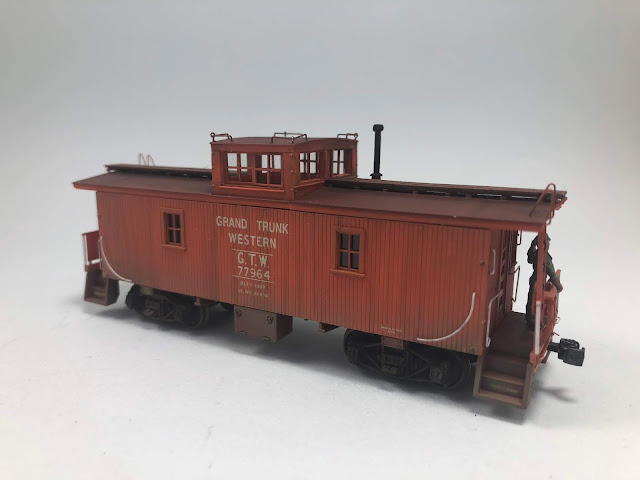To construct the wheel rack I started with strip styrene, which I cut to length, stacked and clamped together. I then used a ball end mill in the milling machine to create the grooves for the wheels to rest in.
The next step was to replicate the sheet metal lining the wheel grooves. This was done with 0.005" styrene. I came up with a method to form it into the semi circle grooves. The pictures pretty much explain the method.
 |
| First glue strip into circular groove(I used an Xacto knife handle to push them down in the groove.) |
 |
| I then clamped the remaining strip portions with a couple pcs of wood. |
Four of these wheel groove parts were assembled into the rack with various sizes of sheet, strip and angle styrene. Resulting in what can be seen in this photo. Rivets harvested from an Athearn boxcar and NBW's were used to detail the rack. The NBW's are not yet installed in this photo.
The car was painted with True Color Freight Car Red. I pieced together decals from sets I had on hand. Unfortunately none of the 'CAPY', 'LD LMT' or 'LT WT' decals I had would fit. I will look for a N-scale set to see if I can make that work. The car number is made up and some of the decals don't perfectly match the CV prototype car, but the number chosen is consistent with other GT service cars of the time.
Weathering was my normal routine of Ak Enamels and Pan Pastels.
The deck wood was simulated by first spraying it with Tamiya Sky Grey. I then mixed up four different washes using Valeo Acrylics. A couple of greys and a couple of browns/sand colours. The wash is very thin. I would guess 80% water and 20% paint. Individual boards are then painted with the washes using a micro brush. After letting it dry for an hour or so, I use Hunter Line Cordovan Brown stain and give the entire deck a light wash. I applied two light washes in this case. I think it simulates old grey wood. This is by far my best effort yet at simulating old grey wood and it is mostly covered up - figures it would work out that way.....
The wheel sets are from Tichy. I wanted them to look like wheels that just came out of service and are on there way from a remote RIP track, back to the wheel lathe in one of the online shops. After assembling the wheel sets I dipped them in Pledge and let them tack up. When ready I dusted on powders to simulate rust. The treads were then painted silver. (If Idid it again I would use a silver Sharpy marker instead.) The finally step was a AK enamel wash (Dark Wash in this case.)
This was a fun project and will ad an interesting freight car to break up the string of endless boxcars in a consist.















































